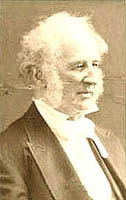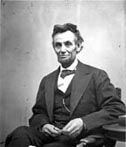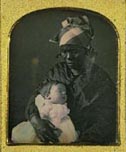Antique Photos and How They Were Made
by Joelle Steele

There are many antique photographs that have survived the last century or so. These images give us a very personal glimpse into a world that is no more, and so they are real treasures. Photographs were made in a variety of ways with different chemicals and other materials, most of which are so fragile that they can be easily destroyed by improper handling. The following is a little mini-encyclopedia of some of the processes used to make these wonderful old images.
Albumen Prints. These images are the most common type of photographs made in the 19th century. They are usually a purplish-red tint and can be either matte or semi-gloss finish, although more are likely to be glossy. The process was invented in 1848 by Abel Niépce de Saint-Victor (nephew of Daguerreotype pioneer Joseph Nicéphore Niépce) and the slow-print albumen paper was invented by French photographer Louis-Désiré Blanquart-Evrard in 1850. Niépce used albumen (egg whites) salted with potassium iodide which was applied to glass, exposed to silver nitrate, exposed to light, and then developed with gallic acid. It worked well, captured fine details, but was impractical for portraiture because of its long exposure time. But the method was used successfully for capturing images of landscapes and architecture.

Then Blanquart-Evrard came along and mixed albumen with salt and applied it to paper which was then treated with silver nitrate, making it light-sensitive. The image was printed under a negative exposed to sunlight, and was then fixed, washed, and mounted. The images on albumen prints resides on top of the paper and because the paper is very thin it tends to curl, so most are attached to card stock. Albumen paper was the most widely used photo printing material from about 1855-1895, and it was still in use as late as the 1920s. Cartes de Visite and cabinet cards were albumen prints. Those that still exist are usually faded to a yellowish brown and may also be stained yellow or brown in their non-image areas.
AMBROTYPES – see COLLODION POSITIVES
Cabinet Photographs. These photographs were larger versions of the very popular “cartes de visite.” They were photographs mounted on cards, a method first used in 1866. They were approximately 4.5″ x 6.5″ (11cm x 16.5 cm) and were being produced well into the 20th century, but they were most popular from 1880 to 1900, becoming more ornate in the 1890s.

Calotypes. These photographs are also sometimes called “salt prints” or Talbotypes, for their inventor, William Henry Fox Talbot. In 1840, around the same time that the Daguerreotype was being invented, Talbot invented the calotype, a photograph on paper made from a paper negative. A sheet of ordinary paper was coated with silver nitrate, dried, dipped in potassium iodide, dried again, floated in a mixture of silver nitrate and gallic acid. This negative was then placed on a sheet of paper that had been immersed in salt water and then coated with silver nitrate. When exposed to light, the print was fixed, washed, and dried. The image was embedded in the fibers of the paper, and could be left “as is,” or glazed to give it a sheen.
Calotypes were generally sepia tones (a reddish brown color). Calotypes were more common in England and never really caught on in the United States, but they were the first practical application of a negative-to-positive photographic method, and they allowed for the production of multiple copies of a single image. Unfortunately, however, the fuzzy calotype images failed to compete with the Daguerreotype’s fine details. But, it is Talbot’s process that was the forerunner of 20th century photography.
Carbon Prints. These photographs were first patented by Joseph Wilson Swan in 1864. They were clear prints with a wide range of tones. A tissue negative contained carbon and other pigments, mixed in a gelatin base made light-sensitive by immersion in potassium bichromate. The image on the tissue negative was washed, transferred to paper, and the tissue backing removed.
Cards-Mounted. There were a variety of photographs mounted onto cards. They were mounted on card stock because the paper on which photographs were printed was so thin that it curled and was easily damaged through handling. Many mounted photo cards were never standardized in size. They include the very popular cartes de visite, cabinet cards, and stereotypes, as well as other lesser-known cards such as the boudoir, imperial, panel, panoramic, promenade, trilby, and Victoria. Trilby cards were probably the smallest at about 2″ x 2.5″ (5cm x 6.5cm), and the largest were probably the imperials at up to 10″ (25.5cm).
Cartes de Visite. These are probably the best-known antique photographic images. They were invented in 1854 by French photographer André Adolphe Eugène Disdéri as an alternative to the embossed or printed calling cards of earlier years. They could be printed on paper and they enjoyed great popularity all the way through World War I. They had a more or less standard measurement of approximately 2.5″ x 3.5″ (6.5cm x 10.5cm), and the oldest versions were quite thin and plain. More ornate mounts with gilt edges and stamping on the front were characteristic of later versions. Most cartes de visite were imprinted with the photographer’s name, and most were portraits.
Cast Mounting. Daguerreotypes and ambrotypes were originally encased in wooden or heavy cardboard boxes covered with leather to protect the fragile images from breaking. In 1853-54, the hinged “union case” was introduced by Connecticut Daguerrian Samuel Peck. It has been described as being made from “gutta percha,” a dark, hard, rubbery or leathery substance made from the latex (sap) of tropical trees, such as the Palaquium and Payenna species of the South Pacific islands and South America. But, they were really made from an early plastic, a thermoplastic resin produced by mixing shellac and wood fiber, which was then press-molded into various designs. Today, we refer to all photographic cases as “union cases.” They were made by numerous manufacturers who marked their cases.
Collodion Process. It is said that Frederick Scott Archer and Peter Fry invented the wet plate collodion process simultaneously with French photographer Jean-Baptiste Gustave Le Gray. This process was still in use in the 1960s in the printing industry. The collodion method was a negative process invented as an alternative to the albumen method. It paved the way for high quality duplication of photographs.

The collodion process required only a two- or three-second exposure time, so this was a definite plus. But, it was also necessary to keep a glass plate wet with collodion, and that meant that a photographer had to carry a lot of chemicals along with his glass plates. This could be quite dangerous, since collodion is a highly flammable and toxic chemical — pyroxylin, a solution of nitrocellulose (“gun-cotton”) mixed with ether or acetone, sometimes with other alcohols as well. The negative process was accomplished using a clear piece of glass coated with a thin layer of iodized collodion dissolved in ether and alcohol and mixed with potassium iodide. The plate was then taken into the darkroom and dipped in a silver nitrate solution that made it light-sensitive. It was immediately placed in the camera and exposed. Afterwards, it was immediately fixed and could then be printed onto any material, usually onto albumen-treated paper.

Collodion Positives. The images produced by this method are commonly referred to as “ambrotypes,” probably after James Ambrose Cutting, the American photographer who took out patents for improvements on the wet collodion process invented by Archer. Collodion positives were made by underexposing iodized collodion on a glass negative, dipping it in silver nitrate, exposing it while still wet, and developing it in a solution of ferrous sulfate and fixing the image with potassium cyanide. It was then bleached and mounted on black cloth (often velvet) in a case, or was painted black on the back of the glass.
The images could be matte or glossy, and the whites were truly white, unlike the faded yellow look produced by the albumen process. They were low contrast, grayish, often hand-tinted, and are usually laterally reversed. Collodion positives were one-of-a-kind photographs, as were Daguerreotypes, which they resemble on the surface. While less reflective and therefore easier to view from any angle than were Daguerreotypes, the collodion positives lacked the detail of the Daguerreotypes, but they had a shorter exposure and developing time and were therefore faster and less expensive to produce, making them available to more people. They were popular between about 1855-1865, when they were replaced by the Cartes de Visite, which were introduced in 1854 by French photographer André Adolphe Eugène Disdéri. But, they were still being made into the 1880s.
Cyanotypes. While this process was invented in 1842 by Sir John Herschel, cyanotypes did not gain popularity until the late 1890s. The images were bright blue with a matte finish. Materials were made light-sensitive with iron salts rather than silver compounds. Cyanotypes were stable and today architectural blueprints are still made using this process.

Daguerreotypes. These encased photographic images were first pioneered in 1827 by Joseph Nicéphore Niépce, and later by his partner Louis Jacques Mandé Daguerre, but were not perfected until 1837, and were not introduced to the public until 1839. In 1837, Daguerre discovered a way to develop photographic plates in only 30 minutes and fix them in a salt bath. This occurred as a result of Sir John Herschel’s announcement of his discovery of the properties of thiosulfate of soda, the forerunner of modern photography’s “hypo” fixing solution.
A Daguerreotype was created using a highly polished silver-plated sheet of metal, usually copper. The plate was made light-sensitive by coating it with iodine vapor/fumes and either chlorine or bromine vapors/fumes. It was exposed inside the camera and then developed using mercury vapor/fumes. The image was fixed with sodium thiosulfate.

The plate had to be housed in an air-proof case in order to protect its fragile materials and prevent tarnishing, and it was necessary to hold it at just the right angle in order to view the image — one way to distinguish a Daguerreotype from other glass plate images. In addition, there were no mirrors in cameras at that time, so the image was always laterally reversed. In its earliest form, the images had bluish-grey tones. In later years, a brown tone (gold chloride) called “gilding” became more widely used. The Daguerreotype produced a very clear, sharp, and detailed image, owing to the use of a very fine lens. Daguerreotypes plate sizes are approximately as follows:
Whole plate 6-1/2″ x 8-1/2″
Half plate 4-1/4″ x 5-1/2″
Quarter plate 3-1/4″ x 4-1/4″
Sixth plate 2-3/4″ x 3-1/4″
Ninth plate 2″ x 2-1/2″
Sixteenth plate 1-3/8″ x 1-5/8″
Dry Plate Process. The dry plate process had been invented in the mid-1850s by Dr. Richard Norris, a British professor of physiology at Queen’s College in Birmingham, England, and it was introduced to the public in 1864. It used a gelatin-based emulsion, but the plates were not sufficiently light-sensitive at that time. The process did not receive adequate attention until 1871, when British physician and photographer Richard Leach Maddox wrote an article about it in the “British Journal of Photography.” In 1878, the process was perfected by George Eastman of Rochester, New York. The gelatin prints made by this process were also called “silver prints” because the light-sensitive compounds used were often either silver bromide or silver chloride, which were coated onto the paper in gelatin. The images are usually silver-grey or brown.
Ferrotypes – See Tintypes
Film. There were different kinds of film produced, starting in the late 19th century with gelatin, which was discovered in the late 1860s. Flexible gelatin film was invented by George Eastman in 1883, and a year later was produced in rolls. Photographic film was introduced by John Corbutt in 1888, and a year later, roll film was invented by Eastman. In 1894, Eastman invented daylight loading film. Gelatin-based film was delicate and was eventually replaced with celluloid, a colorless and highly flammable film made from nitrocellulose and camphor. It wasn’t until 1939 that “safety” film was created from a non-flammable plastic called cellulose acetate. That film was coated with a layer of light-sensitive silver halide salts bonded by gelatin, and produced black and white negatives. With color film, dyes were added to the salts to make them sensitive to different colors.
Gelatin Prints – see Dry Plate Process
Gemtypes – see Tintypes
Glass Plate Negatives – see Collodion Process
Hyalotype. These were positive images produced on glass plates. They were first invented in the 1850s but did not come into widespread use until 1875, at which time they were used in “Magic Lanterns,” which projected them onto a screen, making them the forerunners of 20th century photographic slides.
Melainotype – see Tintype
Mounting – see Cards-Mounted
Panoramic Photos. Early panoramic shots of cities and landscapes were made by placing glass plates side-by-side to form the image. Later, prints were lined up side-by-side to achieve the same panoramic effect. In the late 19th century, cameras were made to produce panoramas. Swing-lens cameras had a lens that rotated and stationary film, and in the 360-degree rotation camera both the camera and the film rotated. After flexible film was invented in the late 1880s, many panorama cameras were invented to use it. In 1904, cameras were invented that used large format film capable of producing 360-degree photographs of up to 20 feet in length. These cameras were on a special tripod and the entire camera rotated, as did its film.
Paper Prints. These are classified according to the type of emulsion coating the paper. They include calotypes, albumen prints, salted prints, carbon prints, platinum prints, and bromide prints.
Platinum Prints. These are very beautiful photographs with many grey tones ranging from silver to black. Brown tones can also be created with this process. The prints are finished with metallic platinum and are resistant to fading. They have a matte finish because the image is embedded in the paper’s fibers instead of coating the surface of the paper. The platinum process was originally invented by Sir John Herschel, inventor of the cyanotype, and was later developed by William Willis, Jr. who introduced platinum prints in 1874.
Polaroids. Polaroid photography was a one-step (“instant”) photographic process invented in 1946. The picture developed partially in the camera and was removed by the (amateur) photographer after a certain number of seconds. Polaroid images were, on the whole, pretty poor quality, lacking in details, and displaying a variety of streaks, over/under-exposed areas, and blurry images. They came in rectangular and square print sizes similar to other snapshot sizes of the second half of the 20th century.
Salt Prints – see Calotypes
Sepia Prints. Sepia prints or sepia tones get their name from a reddish-brown pigment that comes from the Sepia officinalis, or common cuttlefish. In the old photographic processes, sepia prints were created by immersing a print in potassium ferricyanide, washing it, and bathing it in toner, which converted the silver halide to silver sulphide and created the reddish-brown sepia coloration or tone. When a true sepia print fades, it turns pink.
Silver Prints – see Dry Plate Process

Stereotypes. These are images taken with a double-lens camera and then mounted side-by-side on a card. They were then placed in a viewer that created a 3-D effect. They are also called stereo cards or stereoviews and they were produced in very large quantities. The twin images look almost identical, but they are just slightly different. Stereotypes were popular from about the mid-1850s up until the 1920s and 1930s.
Talbotypes – see Calotypes
Tintypes. These photographic images were invented in France in 1853 by a teacher, Adolphe Alexandre Martin. The process was then patented and produced in 1856 in the United Kingdom by William Kloen and in the United States by Hamilton Smith. The images were first called melainotypes, then ferrotypes, and eventually the name “tintype” stuck, especially in the United States where they became very popular well into the 1890s, until the gelatin dry emulsion plates started to replace them, but they were still in wide use throughout World War I and into the 1920s in the United States. They never quite caught on in Europe.
Tintypes were negative images, developed using the wet collodion process, on thin sheets of iron that have a thin black layer of varnish or enamel that makes the image appear as a positive. Like Daguerreotypes, the images are one-of-a-kind and cannot be duplicated, they are negatives so they are always laterally-reversed, and the earliest ones are usually encased. Tintypes range in size from approximately 1.45″ x 1.65″ (3.5cm x 4.2cm) to 6.5″ x 8.5″ (16.5cm x 21.5cm). Some were even smaller and were called gemtypes. A magnet can be used to distinguish the iron tintype from other images mounted under glass. Tintypes were very popular with soldiers during the Civil War because they were so affordable and durable.

Trichrome or Color. In 1861, the first color photograph was made by James Clerk Maxwell, a Scottish physicist and mathematician. He used colored lenses in red, green, and blue and took three photos of the same image, then projected the three images onto the same surface to create a color image.
Union Case – see Case Mounting
Wet Plate – see Collodion Process
This article last updated: 05/09/2012.
Any images in the articles on this Web site are used by permission of the owner or in accordance with the public domain and fair use codes of the United States Copyright Laws for the purpose of educating and informing the readers of this Web site on subjects about or related to photography, antique photography, and digital photo restoration. See Terms of Use for more copyright information.
